
PicoScope 7 Automotive
Available for Windows, Mac, and Linux, the next evolution of our diagnostic scope software is now available.
PicoScope 4823
The 4823 is the world’s first high-speed, high-resolution, 8-channel automotive oscilloscope, and is fast enough for CAN, CAN FD, and FlexRay including serial data decoding. It is ready-configured for automotive probes and includes more than 150 Guided tests, plus access to thousands of comparisons in the Pico waveform library which now supports 8 channels.
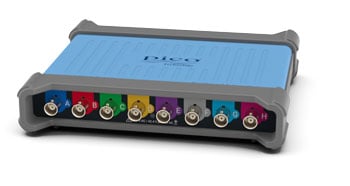

FlexRay Waveform
The PicoScope 4823 can capture high-speed signals that are too fast for many other automotive oscilloscopes. With sampling rates of up to 80 million samples per second, there is nothing that can escape the scrutiny of PicoScope.
CAN and FlexRay are now common on vehicles, and new protocols such as SENT for digital sensors and CAN FD (up to 5x faster than the current CAN standard) now present in some vehicles. The fast sampling rate ensures that the PicoScope 4823 has the speed to handle future needs as vehicle technology changes.

Ignition waveform captured at 8 bits (black) and 12 bits (blue)
A deep waveform memory gives you a high time resolution, but a high vertical resolution is equally important. It allows you to see small changes in signal such as ignition coil oscillations and the small dip in current when an injector opens.
Many oscilloscopes only offer 8-bit resolution which allows 256 vertical steps. As most PC monitors have vertical resolutions of over 1000 pixels, this results in a low-resolution "blocky" display. The PicoScope 4823 has 12-bit resolution (4096 steps), and when not using the full sampling rate of the scope this can be enhanced to 16 bits (65 536 steps).
The image shows the same ignition signal captured at both 8 bits and 12 bits. With the 8-bit oscilloscope the coil oscillations are distorted while at 12 bits they are in clear high definition.
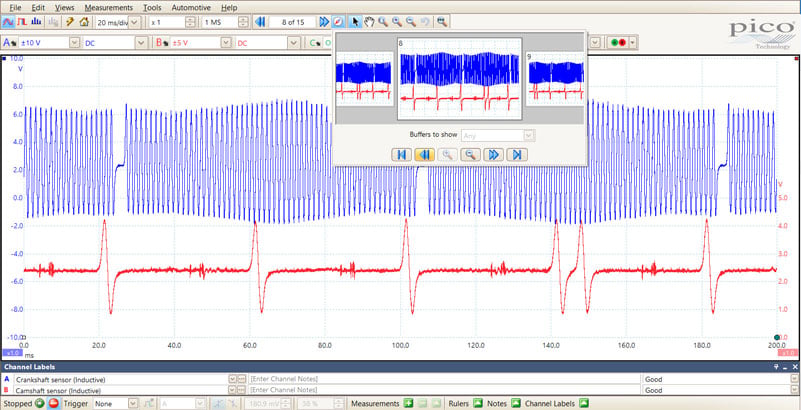
The best way to diagnose an intermittent fault is often to set up the scope to measure from several components and wait for the fault to occur. For an intermittent misfire, you might want to capture several minutes of cam, crank, ignition and injector waveforms. These types of tests require an oscilloscope with a "deep" memory buffer, so that you can capture for long periods of time and then zoom in without any gaps or loss of detail.
With PicoScope you can collect 250 MILLION samples, more than any other automotive oscilloscope. Our advanced "always on" memory technology uses hardware acceleration to make sure that the processing of large amounts of data does not slow the oscilloscope down even when you are using a slower or older PC.
Deep memory allows long recordings at high speed – you capture a complete test drive whilst looking for intermittent faults. When not using the full memory for a single waveform, PicoScope automatically stores up to the last 10,000 waveforms in the buffer, so you can stop the scope and “wind back time” to see every capture.
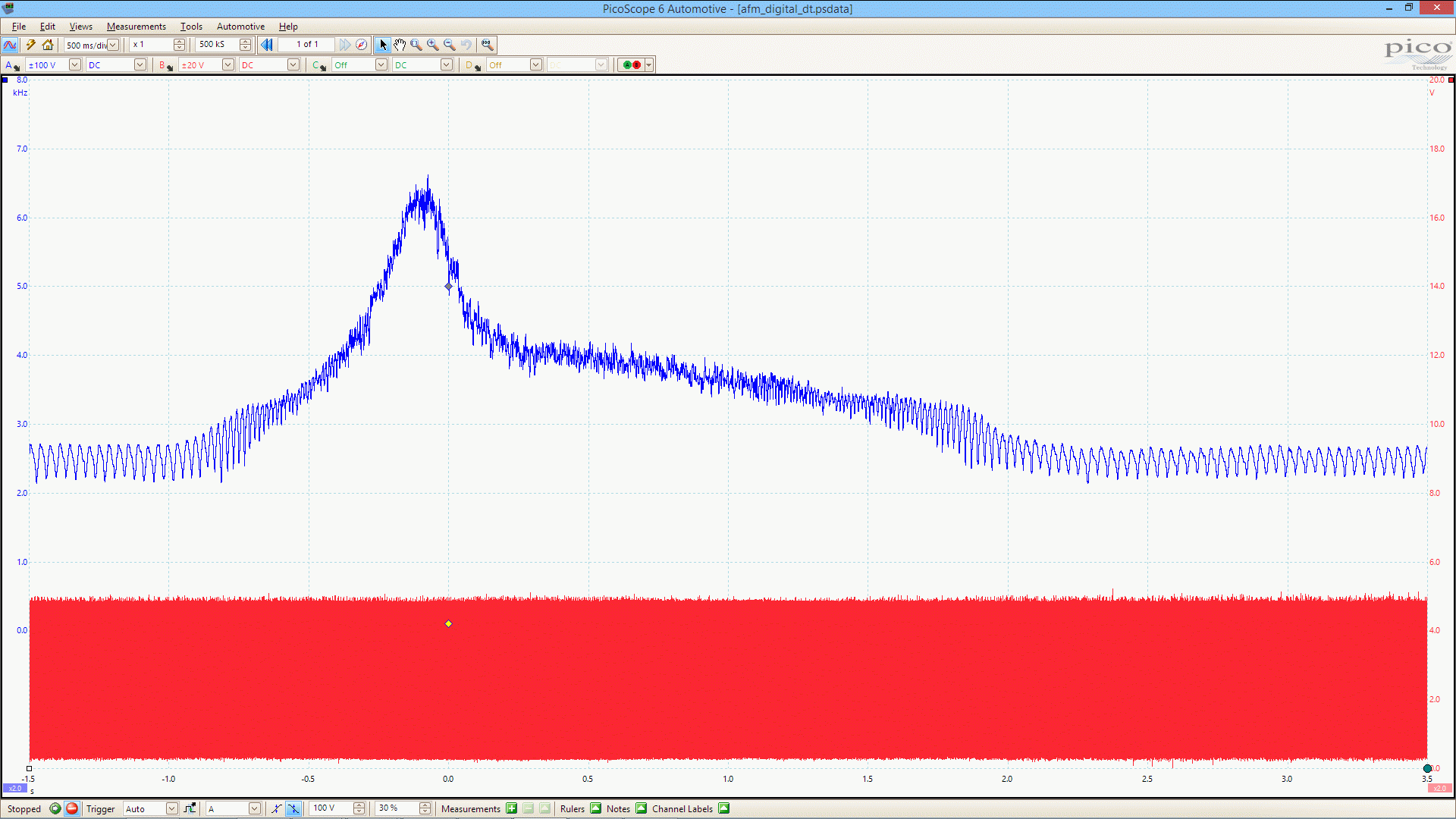
Digital Mass Air Flow (MAF) sensor
Most new users start by using the guided tests to configure all the settings automatically. As your experience grows there are many advanced features to explore. These include:
Every aspect of your PicoScope has been designed for a long working life, and it has the performance to ensure it will not be obsoleted by the changing technology in new vehicles. The hardware is robust and reliable with no moving parts or batteries to fail. Combine this with free support and free software updates for the life of the product and its easy to see why a PicoScope is the choice for professional diagnostics.
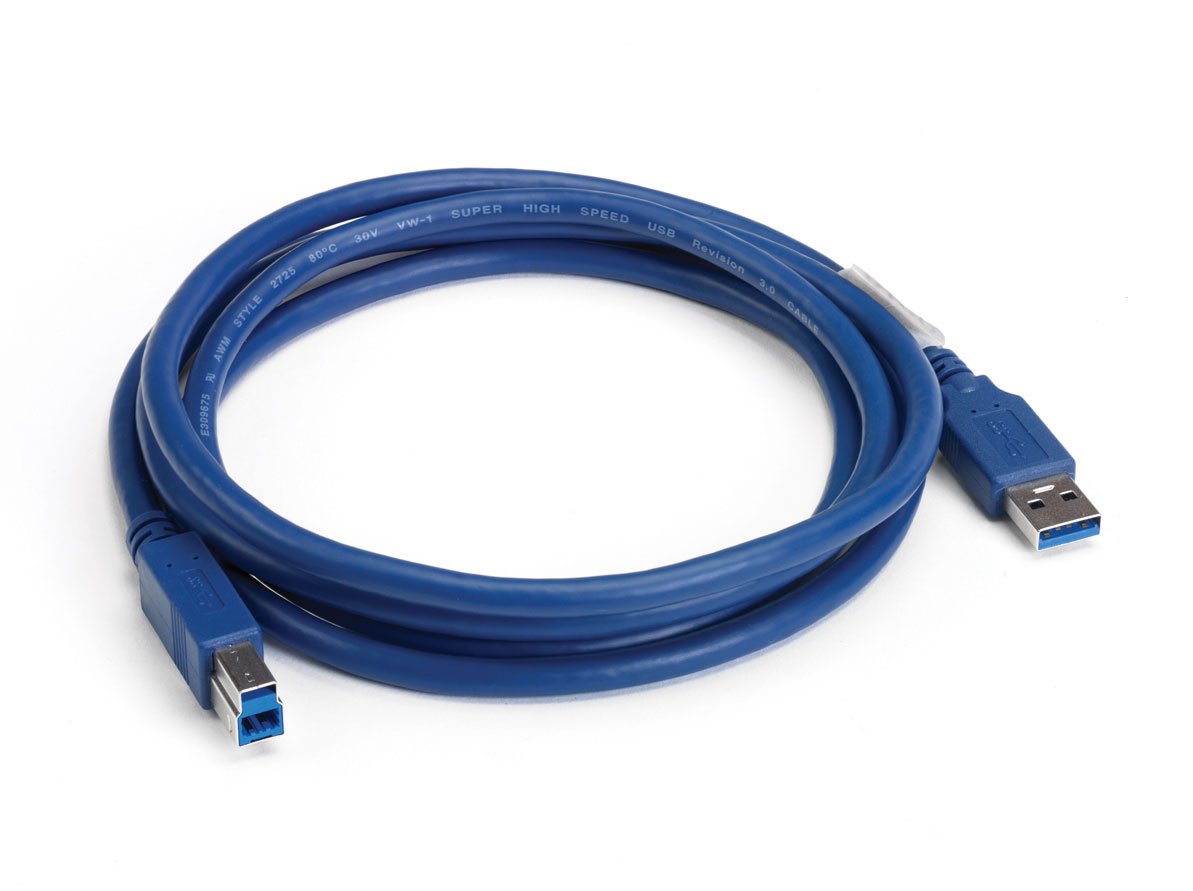
As with all our automotive PicoScope oscilloscopes, no external power supply is required and there are no batteries to go flat, just a simple reliable connection to the USB port.
The PicoScope 4823 has the latest SuperSpeed USB 3.0 port to interface to your PC. Don't worry if your PC only has USB 2.0 ports – the PicoScopes are fully compatible with these too. If you have USB 3.0 on your PC you will notice slightly faster screen update rates, faster file saving and USB streaming. As more of our customers move to PCs with USB 3.0, free software updates will ensure that you get the full benefits available from the new standard.
Our unique fast USB streaming allows continuous gap-free data to be collected straight to PC memory. This makes features like our cylinder balance, battery test and (optional) NVH tests possible. It also allows the oscilloscope to display live, real-time data without waiting for the screen to refresh.
The 2 and 4 channel automotive PicoScopes feature floating input channels - a unique technology that allows safe, low-noise measurements even in situations where none of the inputs are grounded.
In contrast, the 4823 features a common ground connection where grounding any one input also grounds all the others.
On the 4823, the USB ground of the PC connection is also linked to the ground on the BNC outer connectors. In order to minimise the risks to scan tools and other equipment connected to the PC, the 4823 includes special (self-resetting) protection fuses on the inputs limiting any unwanted current flow on the ground in the event that the ground is incorrectly connected.
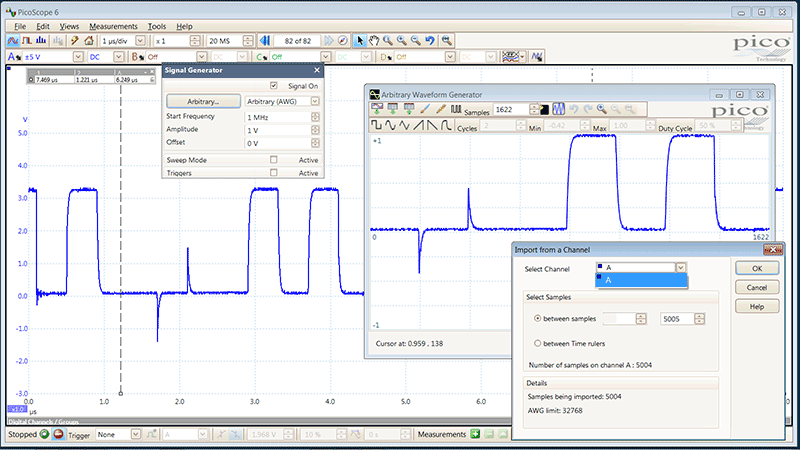
The PicoScope 4823 has a built-in low-voltage function generator (sine, square, triangle, DC level and others) and arbitrary waveform generator. The output voltage range is ±2 V, and so an external amplifier will be required for most workshop applications.
As well as basic controls to set level, offset and frequency, more advanced controls allow you to sweep over a range of frequencies.
The 14-bit 80 MS/s arbitrary waveform generator (AWG) can be used to emulate low-voltage signals. AWG waveforms can be created or edited using the built-in AWG editor, imported from oscilloscope traces, or loaded from a spreadsheet.